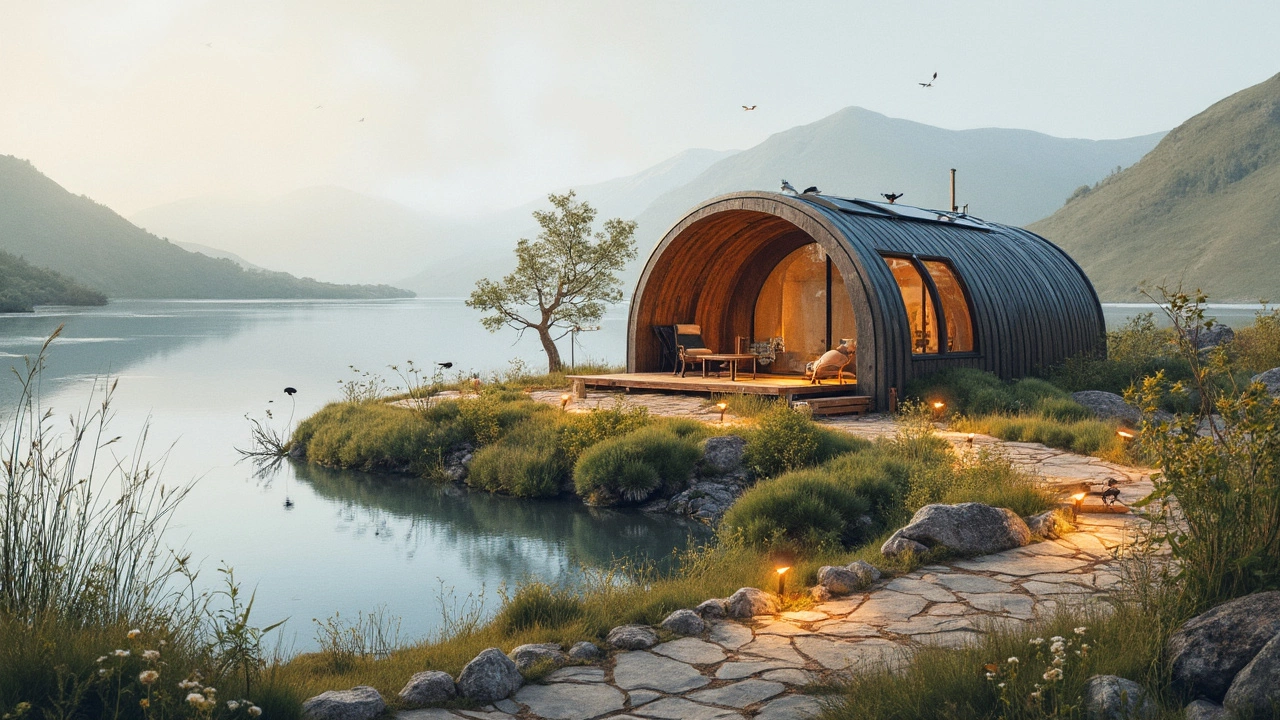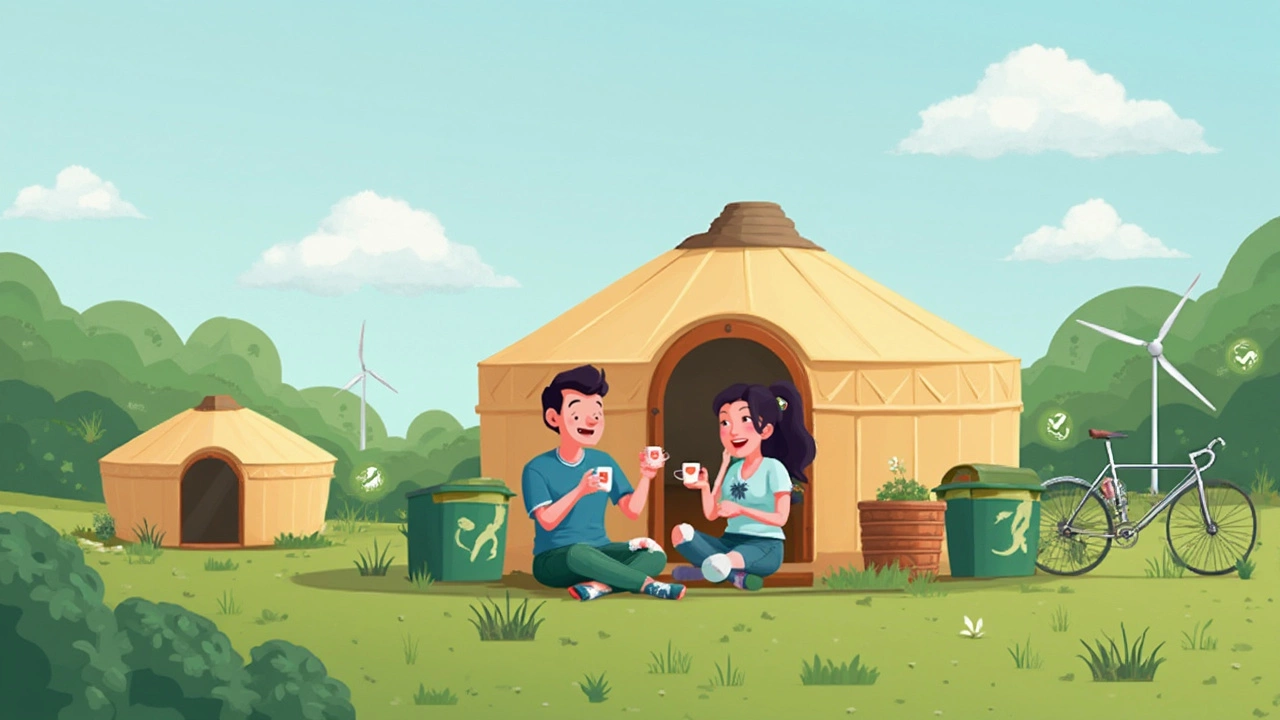How is Glamping Eco-Friendly? Green Getaways Explained
 May, 11 2025
May, 11 2025
Picture this: You wake up under the trees, but you’re not surrounded by trash or noisy generators. That’s the magic of eco-friendly glamping. It’s not just camping with comfier beds—real green glamping is all about treading lighter on the planet while you relax.
So, is glamping really helping nature, or is it just clever marketing? Here’s what actually makes some glamping cottages way more eco-friendly than old-school hotels or even regular camping. I’ll show you the facts, bust some myths, and spill tips on how you can make your stay even greener—without giving up comfort or style.
- What Makes Glamping Eco-Friendly?
- Eco-Tech and Clever Design
- Sustainable Materials in Action
- How to Spot a Truly Green Glamping Spot
- Small Steps Guests Can Take
What Makes Glamping Eco-Friendly?
When people talk about eco-friendly glamping, they mean more than just pitching a tent in the woods. The real game-changer is how glamping sites are built and run. Instead of bulldozing through nature and sucking up resources like big hotels, many glamping spots use clever designs and tech to protect their surroundings.
One of the main reasons glamping stands out as an eco win: it's usually lighter on the land. Many sites use raised platforms or movable structures so you’re not flattening plants or disturbing animal homes. There’s less pavement, so rainwater soaks into the ground instead of causing runoff or flooding.
Then there’s energy use. Glamping cottages rarely rely on massive generators. Solar panels or small wind turbines are pretty common at green locations. Some even have composting toilets or greywater recycling systems—which means you’re not wasting clean water on flushing or watering plants. This cuts down your stay’s impact big time.
Another cool thing? Some glamping hosts only use eco-safe soaps, detergents, and toiletries. Wildlife won’t get sick from harsh chemicals, and rivers stay clean. You’ll often see clearly marked recycling and compost bins, making it easy to keep waste down. Some places even offer local food and refillable water bottles so you don’t need to stock up on plastic.
Glamping can also help keep nature healthy by supporting protected areas or local conservation projects. Some hosts donate a cut of profits to park upkeep or wildlife programs. So every night you spend stargazing or roasting marshmallows helps look after the spot for future visitors.
What’s the takeaway? Glamping can be a lot more eco-friendly than you’d think—if you choose your spot wisely and look for these smart, sustainable features.
Eco-Tech and Clever Design
A big reason glamping wins points for being eco-friendly is the way these cottages use smart technology and design tricks to cut down their impact. Think solar panels soaking up sunshine for electricity or rainwater tanks stashed under decks for showering and dishwashing. Some sites even use compost toilets, which reduce water use by up to 80% compared to classic flush systems.
Many top glamping spots are built to use natural light and airflow, so you won't need to blast AC or leave on lamps all day. This isn’t just good for the environment—it’ll keep you way comfier too. Designers use bigger windows, high-insulation walls, and roofs meant to reflect heat, so it never feels stuffy or chilly inside.
What really sets glamping apart from regular hotels, though, is how tech is blended with the outdoors. Motion-sensor lights, solar water heaters, and off-grid power banks all work quietly in the background. It’s like going wild, but with WiFi (sometimes) and a guilt-free conscience.
Here are some popular eco-tech features you might spot in a modern glamping cottage:
- Solar panels for renewable electricity
- Rainwater catchment and reuse systems
- Composting or low-flow toilets
- LED lights and motion sensors
- Off-grid battery packs or wind turbines
You might wonder if these green upgrades really matter. Numbers don’t lie:
| Eco-Tech Feature | Average Resource Savings per Year |
|---|---|
| Solar panels | Up to 3,500 kWh electricity (enough for a small home) |
| Composting toilets | Up to 20,000 gallons water |
| LED lighting | 75% less energy than old bulbs |
Bottom line? Smart design and eco-friendly tech aren’t just buzzwords—they’re the real tools behind a greener getaway. Next time you book, check which tech touches your spot offers. Your stay (and the planet) will thank you.

Sustainable Materials in Action
It's easy to spot the difference when glamping sites commit to eco-friendliness—just look at the materials they use. Forget plastic-heavy tents or mass-produced furniture. The best eco-friendly cottages focus on renewable, upcycled, or all-natural materials that don’t wreck the planet.
Take bamboo, for example. It grows incredibly fast, doesn’t hog water, and naturally resists pests, so farmers skip nasty chemicals. Many glamping cabins now use bamboo for floors, walls, and even furniture.
Recycled wood is another win. Some sites source salvaged timber from old barns or fallen trees, turning what would be waste into sturdy walls and cozy beds. Even old shipping containers get a second life as modern glamping pods, cutting down on the need for new construction materials entirely.
Nontoxic paints and stains matter too. Traditional paints can release harmful fumes, while low-VOC (volatile organic compound) formulas are safer for both people and the environment. Want insulation? Sheep’s wool pops up in many eco-glamping cabins since it’s biodegradable, naturally fire-resistant, and keeps spaces comfortable in any season.
Here’s a quick look at some materials and why they're better for the planet:
| Material | Why It’s Eco-Friendly | Common Uses in Glamping |
|---|---|---|
| Bamboo | Rapid growth, minimal pesticides, renewable | Floors, walls, furniture |
| Recycled Wood | Reduces waste, no new trees cut | Walls, decks, decor |
| Sheep’s Wool Insulation | Biodegradable, safe, great insulator | Walls, ceilings |
| Recycled Steel | Uses less energy to produce than new steel | Framework, roofing |
| Organic Cotton | Lower water use, fewer chemicals | Linens, towels, curtains |
The push for greener materials isn’t just about building. You’ll find glamping sites swapping out single-use plastics for compostable kitchenware, or using locally sourced stone for patios and firepits. Every smart swap helps keep the footprint low, so you can enjoy nature knowing you’re not leaving a messy legacy behind.
How to Spot a Truly Green Glamping Spot
It’s easy to get lost in pretty pictures and catchy buzzwords, but finding a truly eco-friendly glamping spot takes a sharper eye. Some places slap “green” on the brochure but barely tick the real boxes. Let’s get specific about what actually matters.
First off, look for clear info on how the site uses energy. Solar panels, wind power, and small hydro setups are common on real eco-sites. If there’s no mention of renewables, that’s a red flag. Don’t be shy—ask if they use gas generators or are tied into regular power lines.
Next, check what materials the cottages are built from. Good ones use reclaimed wood, bamboo, or recycled metal—stuff that doesn’t chew up fresh resources. Plastic pods and loads of concrete aren’t eco no matter how cute they look.
You also want to see proof of water saving. Rainwater harvesting, low-flow toilets, and showers are all good signs. Composting toilets mean they’re really going all in. If they talk about luxury hot tubs but not how they save water, be suspicious.
Another thing to spot: how does the glamping site handle waste? Sites with real green goals have clear recycling and composting setups. Some even take waste off-site to be processed in proper facilities. If you see single-use everything and overflowing bins, that’s not a good look.
- Look for official eco-certifications—like Green Key or EcoTourism Australia. These aren’t just logos, they’re earned with audits and proof.
- Read guest reviews and search for comments about sustainability efforts. Real guests will call out the good and the fake.
- See if the glamping site supports local conservation or community projects. Authentic eco-hotspots often donate or pitch in with tree planting or wildlife protection.
The most important tip? Ask questions before you book. If the owners love their eco mission, they’ll be happy to get detailed. If they dodge or give vague answers, move on—there are tons of places getting this right.

Small Steps Guests Can Take
You don’t need to overhaul your entire vacation just to be a bit more eco-friendly. Even on a laid-back glamping trip, small choices add up. In fact, if every visitor did just a couple of these things, eco cottages could cut their resource use by up to 20%, according to a 2023 UK sustainable tourism survey.
- Glamping spots often use solar power, but it still helps to switch off lights and gadgets when you don't need them.
- Bring a reusable water bottle instead of buying plastic ones—some glamping sites report that doing this can keep hundreds of single-use bottles out of landfills every month.
- Stick to the marked trails. Trampling off-path can cause real damage to fragile plants, especially in sensitive habitats.
- Try eco-friendly toiletries (think bar soap instead of little plastic bottles) because most of these places use septic-safe wastewater systems.
- Sort your trash and always compost food scraps if bins are provided. A 2022 study showed that glamping cottages with proper waste sorting cut landfill trash by nearly half versus regular hotels.
It’s also smart to ask before lighting fires, even if it seems allowed; some areas have hidden fire bans or prefer gas stoves to protect the surroundings. And while it might be tempting to crank up the heating or air-conditioning, throwing on an extra sweater or cracking a window to cool down saves energy.
| Simple Action | Impact |
|---|---|
| Using refillable bottles | Saves up to 3 plastic bottles per guest per day* |
| Turning off lights/devices | Cuts cabin electricity use by 10-15%* |
| Sorting waste/composting | Reduces landfill waste up to 50%* |
*Data from Rural Sustainable Tourism Network, 2022-2023
So it's not about being perfect—it's about making simple choices that work for you. Every guest who does a bit chips in for a lighter overall footprint, and that’s what makes eco-friendly glamping actually mean something.